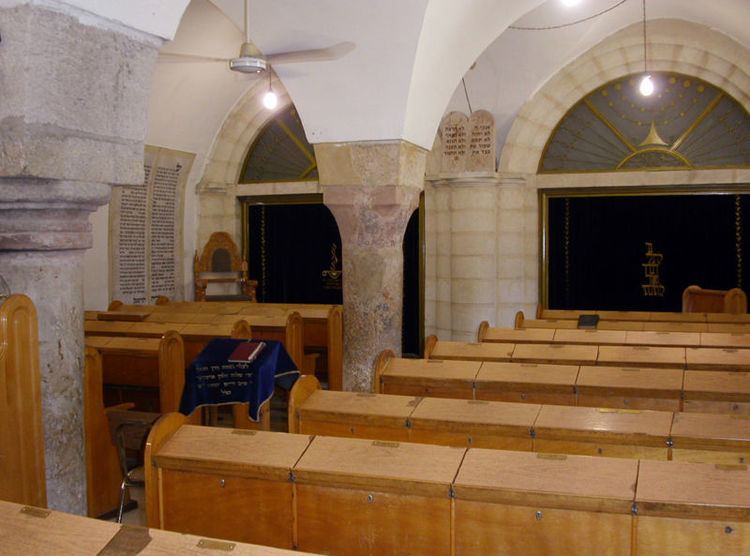Status Active Phone +972 2-623-6223 | Opened 1267 | |
 | ||
Similar Four Sephardic Synagogues, Hurva Synagogue, Tiferet Yisrael Synagogue, Church of the Condemnation, Cathedral of Saint James - J | ||
The ramban synagogue the oldest active synagogue in the old city of jerusalem israel
The Ramban Synagogue (Hebrew: בית כנסת הרמב"ן), is the second oldest active synagogue in the Old City of Jerusalem. It was founded by Nahmanides (Ramban) in 1267, to service the local Jewish community, which would expand due to its presence.
Contents
- The ramban synagogue the oldest active synagogue in the old city of jerusalem israel
- Features
- 13th century
- 16th century
- 19th century
- 20th century
- References
Today there are two Ramban Synagogues in Jerusalem, the original historic one described in this article stands in the Old City; and a new one, established after 1948 and rebuilt in 2005, at 4 Amatsya Street in the Katamon neighbourhood of West Jerusalem.
Features
The foundation of the building comprises vaults resting on Romanesque and Byzantine capitals. Along with the fact that there are no Gothic or Islamic architectural features, this suggests that the original building predates the Crusader period.
The synagogue is located three meters below street level, to comply with Muslim restrictions for Dhimmi houses of prayer not to be higher than mosques.
13th century
After the Disputation of Barcelona, Nahmanides was exiled from Aragon, and in 1267 he made aliyah to the Land of Israel. In an alleged letter to his son, he described the Jewish community of Jerusalem devastated by the Khwarezmian Tatars:
Seventy two years old, he undertook the effort to rebuild the Jewish community and chose a ruined house on Mount Zion to reconstruct it as a synagogue. A number of Jews moved to Jerusalem after hearing of Nahmanides' arrival. The Torah scrolls that were evacuated to Shechem before the Mongol invasion were returned. In three weeks, for Rosh Hashanah, the synagogue was ready for use.
16th century
In 1586, the synagogue was closed under the order of the Turkish governor of Jerusalem. Subsequently, the Sephardi community established their center in the adjacent place, where the academy belonging to the tanna Yochanan ben Zakai was said to have stood during the Second Temple period. Today the Yochanan ben Zakai Synagogue stands there.
The Nahmanides Synagogue shared a wall with the Sidna Umar Mosque and was described as similar in design. Ottoman authorities issued a Firman to lock the synagogue door due to local complaints of 'noisy ceremonies' and further legal disputes were prohibited after the 1598 confiscation.
19th century
In 1835, the leaders of the community managed to obtain a permission from the Ottoman authorities for the renovation of the synagogues, which were unified into a single unit.
20th century
Over the years, the building has been the home to the Sephardi community, was converted into a mosque after being confiscated by a Mufti, and was used as a flour mill and a cheese factory. Today it is used by the Ashkenazi community.
After the 1948 Arab-Israeli War, the building was destroyed by the Arab Legion. As a result of the 1967 Six-Day War, Jews regained their right to the property, and 700 years after the Ramban revived the ancient building, the synagogue was reopened.
